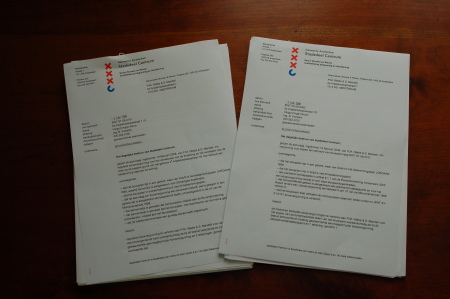No sooner did I press the publish button on my last post than a letter from the city arrived with final approval for the last round of drawings and calculations for my house foundation. Now to get the work started!
Big Projects 2010: House
The foundation repair on my 330 year old house is finally coming together! The final plans were submitted to the city a few weeks ago, and I’m waiting for approval. I’m in very active discussions with a contractor, who I expect will do the work. If nothing serious goes wrong, work should start in about a month.
What an incredible project this has turned into! Contaminated ground, some of the most poorly behaved neighbors I have ever seen, cheated by architects, bad contractors, just everything that could go wrong has, and it has all dragged out for years now. As things start to come together, and the work starts getting done, I plan some posts both explaining what’s happening as well as what’s happened.
What you see in the pictures above are the main larger drawing of my new foundation at the top, including 16 piles 21.5 meters deep. In the blue folders are about 50 pages of mathmatical calculations that describe in detail all of the functioning of the new foundation and all the support the various parts will give. Also on the right is a new steel stability structure that will be installed in my wall to keep my house stable for the future. On the lower left are the plans for a support structure that will be used during the construction that will keep my house from collapsing when the weight is transferred from the old foundation to the new one, which will be particularly important because we’ll be living upstairs at the time.
Foundation Trials and Tribulations and a Bad Constructeur
Some time ago, on a couple of occasions, I’ve posted about replacing the wooden foundation on my now nearly 330 year old house. It’s funny how I’ve gotten so used to saying 325 years, that now 5 years later it’s a struggle to get used to the new number. Since it’s truly become the bane of my existence over the last several months, it’s time to both post an update to let everyone interested know what’s going on, and to take the opportunity to publicly tell off Duyts, the architectural bureau that’s been the biggest source of problems as of late. It’s really amazing how many problems can be caused by a bad architect!
Like I mentioned in my last post, I share a common wall with one of my neighbors. It’s a complicated and age old problem. I own the land under our common wall, and in fact a bit of the land under my neighbors house as well. I have the larger house, and my house is older than my neighbors, by around 100 years. Taking all of these things into account, the city said the common wall was my responsibility. I have to take care of providing a foundation and support for this wall, but my neighbor has to pay the extra costs associated with supporting the weight of that part of his house. In addition, my neighbor has the right to do his foundation together with mine if he wants.
While my neighbor is not very technical, and probably does not understand fully what’s going on, he said very firmly at the beginning he does not want any dependency between our houses, and he will pay the extra costs of my doing that wall, if that’s what’s necessary to keep our houses independent. It’s worth noting that my neighbor taking that decision is turning out to be a very expensive one, as I warned him it probably would be. In layman’s terms, it leaves him a house that has to be supported asymmetrically by his new foundation, as well as having to pay me the costs of supporting that side of his house from my foundation.
Then Comes the Constructeur
There are two architects working on this project. The first one, who is also my advisor and project manager, made the initial drawings of my house that were the basis of the new foundation design. The other architect is called a ‘constructeur’, and is a technical architect. He is the one who actually designs my foundation, as well as the associated building plan. He plans the number and layout of the piles, as well as how deep they have to be. This is really a lot more complicated that it might seem, given the age of my house, the common wall with my neighbor as well as all the stresses a new foundation will put on the house itself, both during and after the building work. If this is done wrong, my house could collapse or I could have long term structural problems. On the other hand all the safety supports which are part of the building plan are very expensive, and erring on the cautious side could costs tens of thousands of euros unnecessarily. A number of steel beams have to be placed before and after the work, and these have to be planned very carefully.
At the beginning we asked for a number of quotes from constructeurs, and we choose Duyts, mostly because they were the least expensive. They started by making a draft drawing of a proposed foundation, that we could use to get feedback from contractors and others, so that minor changes could be incorporated later into a final version. This draft was also used as a way to get quotes from contractors for the work, and in this way we have already chosen a contractor. This draft seemed okay, but honestly there were some problems, mostly requiring extensive work around the existing stairway that didn’t seem necessary. We also had a number of rather stupid issues, like the constructeur forgot an important support structure, during a new phase I was asked to accept extra charges that in fact we had in writing were part of the original quote, and some other smaller things that are a little hard to explain clearly here.
Then it was time. We had accepted a quote for the work from a contractor, had a tentative start date for the work, and signalled the constructeur to do the final drawing incorporating the feedback on needed changes. We were promised the drawing in a week (it was complicated enough that he probably spent most of that time working on it), and even though he was a week late he finished and sent the drawing directly to the city for their final approval before the work would begin.
The only problem was the constructeur totally changed the drawings in the meantime!
Since my neighbor who decided did not want a connection between our foundations also started work on his foundation, and choose the same architectural bureau, the constructeur decided to combine our houses. When I called on the constructeur to explain himself, explain why he didn’t let us know in advance he was going to do that, and correct the mistake by redoing the drawings, he was indignant. It was simply better, he said. He said that because he now had the drawings from my neighbor, he had new information of the situation being different and he didn’t need to tell us he was going to change anything. I’m still seething at the arrogance that lies behind a statement like that, and the idea that whatever this architect says he thinks I have to accept, because he knows better what my house needs than me.
Besides the fundamental problem of combining my foundation with my neighbors, there are other obvious technical problems in the latest drawings, including not enough space being left for my stairway, the only means of getting into my house.
Starting Over
So now I’m in a situation where I realize what a total idiot this constructeur is, I guess it’s my fault for choosing the cheapest, and I suppose you get what you pay for.
His position is still that he hasn’t done anything wrong, and while perhaps I could eventually convince him to redo the drawings, I’m far beyond that now. My house is too important for such an idiot to plan my foundation, so I will look for someone else to do the drawings and do the building plan.
Of course he is expecting me to pay thousands of euros for the incorrect drawings, which I won’t, and this may lead to confrontation in court.
Of course there is no guarantee another constructeur will be able to use the original draft drawings as a basis for my foundation, because they may be wrong or the constructeur may simply have a different methodology. This would mean the current quote that I’ve accepted for the foundation work can’t go forward, that may result in the contractor asking me to pay compensation.
It’s also very likely starting from scratch could mean it takes a month or more extra time, delaying the project that much further.
Amsterdam Farmer’s Market

I’ve been meaning to post some pictures of our local Saturday farmer’s market for some time now. Last Saturday I took my camera along. Honestly it’s mostly locals who shop at this market, and someone with a camera really stands out and kind of gets in the way, which is why I haven’t made this post earlier. Above is a picture of the entrance. Everything sold at this market is supposed to be organic, but much of it is not certified. As far as I know, there is only one other organic market in the city, and mine is the only true farmers market as the other is simply run by independent market stand operators.
The horse was just dumb luck. We don’t normally have horses at the market. There are however a couple of horses that ride around the city giving rides and tours to tourists, and just as I picked up my camera one went past the market. A photo moment!
This market has a Dutch language website here. You might have some luck using Google language tools to translate it.

Above is my favorite cheese stand. They are a farm, and they do sell some of their own cheese. Mostly what they have done is collect organic artesian cheeses from small farms around Europe, and sell them. They are really expensive, but also have some very nice cheese.

The honey guy (above) is usually there, selling honey and honey related products.

There are only about 4 or 5 stands selling vegetables regularly, and this is one I like because it’s reasonably priced and of good quality. This market is actually on the small side, when all is said and done.

The most exotic stand there sells only mushrooms. Besides being very expensive, I honestly haven’t found much use for them. I like mushrooms, but I don’t really know how to cook most of these.
Besides these stands, others sell fruits and juices, grains, house plants, cheese, olives, breads and meats. Almost all the food related stands have farms behind them, but often sell other products that aren’t their own. There’s a stand that sells vegetarian goodies like handmade sushi, pate, sandwiches and so on. On the back side there are stands selling things like clothes and household things. There’s a woman who runs a Scottish baked goods stand, and there is a power foods stand where you can stock up on wheat grass juice and goji berries. Other stands come and go, and I’m sure I’ve forgotten a few.
I guess what I don’t like are the many non farmer’s market aspects to this market. Many stands sell things that aren’t their own, and these things often come from far away. I saw oranges this week, and these must have come from the southern hemisphere. I was hoping to get a picture of some the the large bunches of bananas that often adorn the market and must come from elsewhere, but there weren’t any this week.
You often see things like chestnut mushrooms, which all the food stands sell, all look exactly the same, cost about the same, and you know come from the same wholesaler.
While I sometimes appreciate being able to buy these things while I’m shopping at the market, and I have a lot of respect for the need for farms to work together because it’s pretty hard for one farm to provide enough variety year round to stock a single market stall by themselves, this really goes far beyond that. This is really a local farmers market, integrated with large scale food wholesalers. Also while I say local, many farms come from far away and are on the large side.
Also none of these farms offer Community Supported Agriculture subscriptions, at least via their market stalls. What sort of a true small farm would not choose to offer a CSA?
In fact, as far as I know, true CSAs are not available in Amsterdam. What we have here instead is the polar opposite, and it’s called a ‘Vegetable Subscription’. It’s run by the country’s largest organic produce wholesaler and is simply a selection of their choosing of all the leftover products that goes unsold through other channels. Real CSAs couldn’t compete with this on a price basis, and I think most Amsterdammers wouldn’t understand the difference, so it’s unlikely CSAs will take off here anytime soon.
What I just said about CSAs only applies to Amsterdam and probably most large Dutch cities. In the outlying areas I think there are lots of CSAs available, but I’m not really sure.
Building Permits

They have arrived!
I’ve posted before about the repair of my 325 year old wooden house foundation.
Two permits arrived a few days ago, a demolition permit to remove the ground floor and the building permit for the new foundation. The great paper chase is almost over!
Some key points in the permits are:
The technical architect needs to do more work. In particular, I have a common wall with one of my neighbors who is not repairing his foundation at the same time (even though his is in bad shape too). I need to stabilize this wall using support only from my foundation and this requires extra piles and a special concrete structure. The technical architect needs to do another ground test to verify the depth of the stable ground layer and combine this with some more calculations for this special wall support. The good news is I get to bill my neighbor for half the extra cost this support is costing!
Bad News: My ground is seriously contaminated with heavy metals! Good News: The main problem is zinc (Zn), which is non-toxic to humans, in fact it can even be purchased as a food supplement. There are only slight traces of mercury (Hg) and lead (Pb). The ground under my house has to be dug up anyway as part of the foundation repair, so the main consequence is I will have to pay to have it disposed of as chemical waste and replaced with clean sand. The city will also inspect the building site and insure there is no spread of the contamination during the work. If anyone is interested, apparently zinc comes primarily from metal smelting.
An archaeological study is needed, and someone from the city will come and have a quick look when they tear up the floor. If nothing is obvious, the foundation repair can go as planned.
Next Step Quotes
We have requested a couple of quotes from contractors. We have two quotes in. One was just bad, the contractor didn’t understand what was going on. The other was good, but since we don’t have much to compare it with, we don’t know if it’s the right price.
Already one contractor has pulled out completely. He said this business with the wall with the neighbors is just too complicated for him.
We’re waiting for one more quote, but we might ask for more too. The main problem is there are not many more contractors around to ask quotes from.



